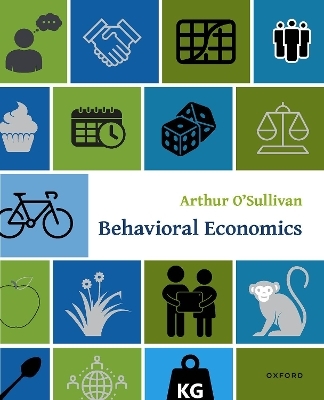
Behavioral Economics
Oxford University Press Inc (Verlag)
978-0-19-751592-1 (ISBN)
Arthur O'Sullivan is Dr. Robert B. Pamplin Jr. Professor of Economics at Lewis & Clark College. He is the author of Urban Economics, Ninth Edition (2019), the best-selling urban economics text, and co-author, with Steven Sheffrin and Stephen Perez, of Economics: Principles, Applications, and Tools, Tenth Edition (2020).
Part 1: Introduction
Chapter 1. Introduction & Key Concepts of Microeconomics
1. What is Behavioral Economics?
2. Key Concepts: Marginal Reasoning
Opportunity Cost
The Marginal Principle
The Equimarginal Principle
3. Key Concepts: Equilibrium and Efficiency
Nash Equilibrium
Comparative Statics
Pareto Efficiency
Chapter 2. Insights from Behavioral Science
1. Social Preferences and Social Norms
Adam Smith and the Impartial Spectator
Rule Following Task: Avatar Pedestrian
Sharing the Rewards of Collaboration
The 50-50 Norm
Incurring a Cost to Enforce a Social Norm
2. Mental Shortcuts
Mental Accounting
Default Options
3. Cognitive Bias
The Decoy Effect
Present Bias
4. Problems with Probabilities
Rare Events
The Gambler's Fallacy
5. Instinctive Urges and Thoughtful Deliberation
Apple versus Cupcake
Hunting Practices of the Ju/'hoansi
Why Do We Do That?
Appendix to Chapter 2
1. Anchors
2. Confirmation Bias
3. Overconfidence Effect
4. Availability Heuristic
Part 2: Social Preferences and Pro-Social Behavior
Chapter 3. Social Norms: Sharing and Enforcement
1. Utility Maximization with a Social Norm
Utility Maximization
2. Sharing Behavior: The Dictator Game
Game Structure and Results
Variation in Sharing Behavior
3. Costly Norm Enforcement
Third-Party Punishment of Norm Violators
Structure of the Ultimatum Game
A Norm-Sensitive Responder
Equilibrium Responder Share
A Norm-Sensitive Proposer
4. Results from Ultimatum-Game Experiments
Meta-Analysis of Ultimatum Experiments
Crosswalk Rules and the Ultimatum Game
5. Market Engagement and Social Norms
Chapter 4. Trust
1. The Trust Game: Investment & Production
Game Structure
Outcome in the Absence of a Sharing Norm
2. A Sharing Norm for the Producer
The Producer's Trade-Off: Material Benefit versus Norm-Violation Cost
Varying Norm Sensitivity and Return Fractions
The Investor Decision
3. A Sharing Norm for the Investor
The Investor's Trade-Off: Material Benefit versus Norm-Violation Cost
Relative Norm Sensitivity and Equilibrium
Social Norms, Efficiency, and Social Capital
4. Experiments and Implications
Experimental Results
The Trust Game and Social Capital
The Trust Game and Oxytocin
Chapter 5. Public Goods and Voluntary Contributions
1. Free Riding and Economic Experiments
The Free-Rider Problem
Results from Voluntary-Contribution Experiments
2. Social Norms and Voluntary Contributions
Norm: Efficient Contribution
Norm: Equal Contribution
Explaining a Path of Decreasing Contributions
3. Punish Free Riders?
Punishing Norm Violators
Summary of Experimental Results
Chapter 6. Identity, Norms, and Reciprocity in the Workplace
1. Worker Reciprocity and Social Capital
Perfect or Imperfect Information in the Workplace?
Social Norms and Pareto Improvements
2. Worker Identity and Effort
Utility-Maximizing Effort
Insiders versus Outsiders
Norm Sensitivity and Effort
Producer Investment in Identity Management
3. Response to a Higher Wage
Wages and a Sharing Norm
Wages and the Work-Effort Norm
Wages and Profit
4. Evidence of Worker Reciprocity
Field Experiments
A Gift-Exchange Experiment
Chapter 7. Voluntary Prices
1. Voluntary Prices: Pay What You Want
The Equal-Sharing Price and Norm-Violation Cost
Sustainability of PWW Systems
Economic Experiment: Pay What You Want versus Pay It Forward
2. Public Broadcasting: Free Riders and Guilt-Tripping Pledge Drives
Payoffs to Members and Free Riders
Choosing the Length of a Pledge Drive
Chapter 8. Imitation and Cultural Learning
1.Imitation and Conformity
Over-Imitation by Humans
Over-Imitation: Humans versus Chimpanzees
Conformity and Matching Pennies
2.Faithful Imitation and Cultural Learning
Manioc and Obscure Production Processes
Social Learning: Humans versus Chimpanzees
Part 3: Time Preferences
Chapter 9. Discounting and Present Bias
1. Conventional Discounting and Present Bias
The Quasi-Hyperbolic Discount Function
Present Bias and Doubling Your Apples
Time Inconsistency
Time Inconsistency and the Relative Values of Bundles
Present Bias and Regret
2. Estimates of Discounting Parameters
Estimates of Conventional Discounting and Present Bias
Economic Experiment: Patience among Mothers and Children
3. Illustrations: Cupcake, Weed, Bucket List
Cupcake versus Apple
Homeowner versus Weed
The Bucket List
Chapter 10. Time Preferences and Saving
1. Discounting and Intertemporal Choice
Saving and the Equimarginal Principle
Present Bias and Regret
2. Saving Mandates and Nudges
Response to Mandate: Active Saver
Response to Mandate: Non-Saver
Nudges: Defaults, Save More Tomorrow, and Saving Lotteries
Clueless versus Savvy Consumers
Three-Period Model of Intertemporal Choice
Consumption Path of the Clueless (Naif)
Regret of the Clueless
Consumption Path of a Savvy Consumer
Commitment Devices and Saving
4. Present Bias and Pre-Commitment by Pigeons
Chapter 11. When to Act
1. Procrastination: Waiting Too Long
Present Bias and a Clueless Decision-Maker
Conditions for Procrastination
2. Self-Awareness and Procrastination
Backward Induction
Evidence of Present Bias and Self-Awareness
Clueless versus Self-Aware: How to Tell the Difference
3. Preproperation: Acting Too Soon
Present Bias and a Clueless Decision-Maker
Conditions for Preproperation
4. Self Awareness and Preproperation
Backward Induction
Is Being Clueless Better?
Chapter 12. Application of Present Bias--Sin Taxes and Fertilizer
1. Personally Harmful Products and Sin Taxes
A Model of a Personally Harmful Good
Present Bias and a Personally Harmful Good
Savvy Consumers and Hobbling
Support for Sin Taxes
2. Present Bias and Fertilizer Investment
Review of Intertemporal Choice Model
Present Bias and the Fertilizer Investment
Policy Options: Subsidy versus Nudge
Part 4: Mental Accounting and the Endowment Effect
Chapter 13. Mental Accounting for Consumers
1. Mental Accounting and Fungibility
Consumer Budgets and Fungibility
Mental Accounting and Coupons
2. Other Implications of Consumer Mental Accounting
Mental Accounting and Sunk Cost
Decoupling Cost and Benefit: Credit Cards and Ride-Hailing Services
Regular versus Premium Gasoline
Chapter 14. Loss versus Gain
1. Asymmetric Influences of Loss and Gain
The Greater Weight of Loss
Measuring the Greater Weight of Loss
Reappraisal and the Weight of Loss
2. The Endowment Effect
Willingness to Pay versus Willingness to Accept
Classic Endowment Experiment
Evidence for the Endowment Effect
Endowment Effect for Chimpanzees and Capuchin Monkeys
The Endowment Effect and Exchange
Greater Weight of Loss and Loss Aversion
Part 5: Risk Preferences and Decisions in Uncertain Environments
Chapter 15. Risk Preferences and Prospect Theory
1. Features of Prospect Theory
Utility Function for Prospect Theory
Utility Value and Certainty Equivalent
2. Risk Aversion and Risk Neutrality
Risk Aversion and the Risk Premium
Risk Neutrality: Linear Utility and No Loss Aversion
Sources of Risk Aversion
3. The Values of Key Parameters
Relative Weight of Loss
Decreasing Sensitivity to Gain and Loss
Measuring Sensitivity to Stimulus
Economic Experiment: Risk Preferences and Cognitive Ability
4. Risk Preferences of Rats
Chapter 16. Problems with Probability
1. Probability in Prospect Theory
Prelec Probability Weighting
Psychological Foundations
A Closer Look at Rare Events
2. Learning by Description versus Learning by Experience
3. Solving Puzzles with Probability Weighting
The Numbers Game Puzzle
The Longshot Puzzle
Chapter 17. Prospect Theory & Asset Markets
1.Decreasing Sensitivity and Attitudes toward Risk
Decreasing Sensitivity to Gain and Risk Aversion
Decreasing Sensitivity to Loss and Risk Seeking
Constant Sensitivity and Risk Neutrality
2. The Disposition Puzzle
Reservation Price in a Winner Market
Reservation Price in a Loser Market
Reservation Prices and Time on the Market
Evidence for the Disposition Puzzle
3. Disposition Puzzle Disappears?
Let Bygones be Bygones
Constant Sensitivity to Gain and Loss
4. The Equity Premium Puzzle
Greater Weight of Loss and Loss Aversion
Loss Aversion Solves the Equity Premium Puzzle
Professional Traders: Too Much Information?
Chapter 18. Prospect Theory and Insurance
1. Decreasing Sensitivity and the Willingness to Pay for Insurance
Decreasing Marginal Disutility of Loss
Certainty Equivalent and Willingness to Pay for Insurance
Willingness to Pay for Insurance versus Break-Even Price
Economic Experiment: Willingness to Pay for Insurance
2. Probability Weighting and Insurance Puzzles
Decreasing Sensitivity and Probability Weighting
The Hazard-Insurance Puzzle
The Insurance-Deductible Puzzle
Chapter 19. Reference Points and Goals
1. Goals and the Marginal Principle
Goal-Related Marginal Benefit
Full Marginal Benefit and Choice
Goals on the Golf Course
2. Applications: Rainy Day Taxis and Abstinence
Applications: Rainy-Day Taxis and Abstinence
Rainy-Day Taxis
Inefficiency and a Pareto Improvement
Abstinence
Part 6: Natural Selection and Culture
Chapter 20. Natural Selection and Co-Evolution of Genes and Culture
1. Background Concepts from Evolutionary Biology
DNA, Genetic Mutations, and Natural Selection
Illustration: A Fire-Building Manual
2. A Closer Look at Fitness and Evolution
Fitness, Natural Selection, and Evolution
Fitness Contests and Geometric Mean Fitness
Economics versus Biology: Spider Somersaults
3. Genes, Environment, Norms, Culture, and Cognition
Genes and the Environment
Genes and Culture
Genes and Social Norms
Instinctive Urges versus Thoughtful Deliberation
Chapter 21. Cooperation
1. Humans versus Chimpanzees
Cooperation: Skills and Motivation
Sharing
Bearing a Cost to Enforce Norms
2. Consumption and Production Benefits of Cooperation
Benefits from Consumption Smoothing
Benefits from Economies of Scale
3. Co-Evolution of Genes and Culture
Genes and Culture
Cultural Learning
Chapter 22. Loss Aversion and Time Preferences
1. Natural Selection and Loss Aversion
Steady versus Fluctuating Reproduction
Gain Equals the Loss
Gain Exceeds the Loss
Fitness Equivalence
Environmental Conditions and Genetic Mixes
2. Natural Selection, Culture, and Time Preferences
Trade-Offs from Investment
Low Investment Productivity
High Investment Productivity
Lessons from Historical Data
Chapter 23. Natural Selection and Risk Preferences
1. Small Reward and Risk Aversion
Geometric Mean Fitness
Natural Selection and Risk Aversion
2. Large Reward and Risk Neutrality
Greater Fitness for Risk Takers
Natural Selection Favors Risk Taking
Fitness Equivalence
Risk Aversion in Bonobos, Shrews, and Other Creatures
3.Subsistence and Risk Seeking
Subsistence and Risk Preferences
The Flexible Risk Preferences of Juncos
Chapter 24. Bargaining and the Endowment Effect
1. A Hunter-Gatherer Exchange Economy
Hunter-Gatherer Fitness
Edgeworth Box and Gains from Exchange
Bargaining and Equilibrium
2. Natural Selection: Bargaining Outcomes
Endowment Effect and Nash Equilibrium
Disagreement Value and the Nash Bargaining Solution
The Endowment Effect and Group Fitness
Egalitarian Economy and the Endowment Effect
Glossary
References
Index
| Erscheinungsdatum | 06.06.2022 |
|---|---|
| Verlagsort | New York |
| Sprache | englisch |
| Maße | 234 x 191 mm |
| Gewicht | 835 g |
| Themenwelt | Wirtschaft ► Volkswirtschaftslehre ► Mikroökonomie |
| ISBN-10 | 0-19-751592-4 / 0197515924 |
| ISBN-13 | 978-0-19-751592-1 / 9780197515921 |
| Zustand | Neuware |
| Haben Sie eine Frage zum Produkt? |
aus dem Bereich


